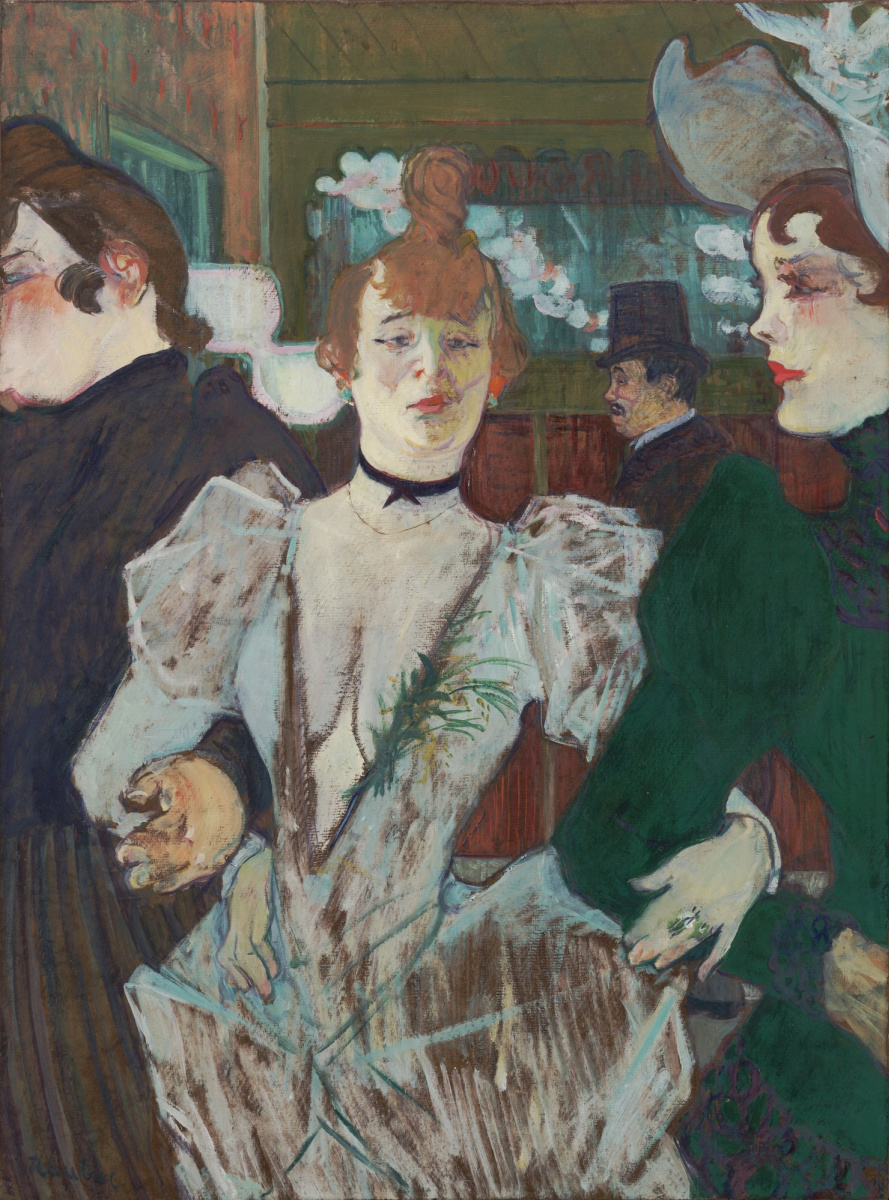log in
Enter site
Login to use Arthive functionality to the maximum
La goulue at the Moulin Rouge
Henri de Toulouse-Lautrec • Painting, 1892, 79.4×59 cm
Description of the artwork «La goulue at the Moulin Rouge»
In the scene "La Goulee at the Moulin Rouge." (The title variant is La Goule enters the Moulin Rouge) Henri de Toulouse-Lautrec depicted the star of a popular Parisian cabaret, the famous French cancan dancer, who was known as the queen of Montmartre. Here she appears surrounded by her sister (right) and mistress (left).
Louise Weber, nicknamed La Goule ("The Insatiable"), was the heroine of many of Toulouse-Lautrec's works. She was an ambitious laundress from a Parisian suburb. As a teenager, Louise wore the clothes of her clients' laundry, and in the evenings she ran to dance at nearby establishments. She earned her nickname La Goule because of her greedy love of life and her habit of emptying customers' glasses while dancing. She came up with the idea for the final ending of the cancan, which was a frenzied rhythm, with a dizzying leap and a squealing twine.
La Goule quickly rose to fame, dancing in see-through pantaloons, posing topless in photographs, and cultivating a reputation as an unbridled lecher. Her outfit consisted of a deep-cut dress, a sporty hairstyle that many copied, and a black ribbon choker. Louise Weber's appearance was so distinctive and recognizable that Toulouse-Lautrec did not even need to show her from the front. Such images demonstrate his interest in Japanese ukiyo-e woodblock prints, in which characters are often identified by gestures, hairstyles or accessories rather than traditional likenesses.
This painting is also related to ukiyo-e by its shallow space, bold cropping, and heavy, shape-levelling outlines. These painting techniques were also used Edgar Degashe considered La Goule of Moulin Rouge to be one of his finest cabaret works. The author considered La Goule at the Moulin Rouge one of his best cabaret works and exhibited it four times in the year following its completion.
In 1895, La Goulou, who had become rich, left the Moulin Rouge at the height of her fame and decided to start her own business. She invested a considerable amount of money in a circus that toured the country and performed at major fairs. However, the public did not appreciate the new show, and the former dancer went bankrupt. After a series of setbacks in both her personal and artistic life, Louise Weber fell into depression and alcoholism. In 1928 she returned to Montmartre, where she earned a living selling peanuts and cigarettes near the Moulin Rouge. However, few people recognized in the flabby beggar former queen of cancan.
La Goule died at the age of 62 and was buried in the Pantin cemetery in 1929. Sixty-three years later, her remains were transferred with great fanfare to the Montmartre cemetery.
Louise Weber, nicknamed La Goule ("The Insatiable"), was the heroine of many of Toulouse-Lautrec's works. She was an ambitious laundress from a Parisian suburb. As a teenager, Louise wore the clothes of her clients' laundry, and in the evenings she ran to dance at nearby establishments. She earned her nickname La Goule because of her greedy love of life and her habit of emptying customers' glasses while dancing. She came up with the idea for the final ending of the cancan, which was a frenzied rhythm, with a dizzying leap and a squealing twine.
La Goule quickly rose to fame, dancing in see-through pantaloons, posing topless in photographs, and cultivating a reputation as an unbridled lecher. Her outfit consisted of a deep-cut dress, a sporty hairstyle that many copied, and a black ribbon choker. Louise Weber's appearance was so distinctive and recognizable that Toulouse-Lautrec did not even need to show her from the front. Such images demonstrate his interest in Japanese ukiyo-e woodblock prints, in which characters are often identified by gestures, hairstyles or accessories rather than traditional likenesses.
This painting is also related to ukiyo-e by its shallow space, bold cropping, and heavy, shape-levelling outlines. These painting techniques were also used Edgar Degashe considered La Goule of Moulin Rouge to be one of his finest cabaret works. The author considered La Goule at the Moulin Rouge one of his best cabaret works and exhibited it four times in the year following its completion.
In 1895, La Goulou, who had become rich, left the Moulin Rouge at the height of her fame and decided to start her own business. She invested a considerable amount of money in a circus that toured the country and performed at major fairs. However, the public did not appreciate the new show, and the former dancer went bankrupt. After a series of setbacks in both her personal and artistic life, Louise Weber fell into depression and alcoholism. In 1928 she returned to Montmartre, where she earned a living selling peanuts and cigarettes near the Moulin Rouge. However, few people recognized in the flabby beggar former queen of cancan.
La Goule died at the age of 62 and was buried in the Pantin cemetery in 1929. Sixty-three years later, her remains were transferred with great fanfare to the Montmartre cemetery.


